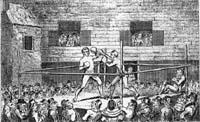June 2, 2009 |
Baltimore Bibliophiles

 One of America's distinguished bibliophilic societies is celebrating its golden anniversary these days between the hard covers of a fabulous book that proves the old maxim that really good things are worth waiting for. The Baltimore Bibliophiles, you see, actually observed their fiftieth birthday in 2004; but a comprehensive book recalling the first half-century of the group--with numerous essays and pertinent illustrations, all of it put together splendidly--has just been issued in a lovely hardcover edition, "The Baltimore Bibliophiles at Fifty: 1954-2004. Edited by Donald Farren and August A. Imholtz Jr., it features a marvelous local history of children's literature by Linda E. Lapides, a former librarian of the Enoch Pratt Free Public Library in Baltimore, and with her husband, Julian L. Lapides, a major collector of children's books over many years. The edition is limited to 300 copies; a limited number is available from Oak Knoll Press, $55 each (see link above to order.)
One of America's distinguished bibliophilic societies is celebrating its golden anniversary these days between the hard covers of a fabulous book that proves the old maxim that really good things are worth waiting for. The Baltimore Bibliophiles, you see, actually observed their fiftieth birthday in 2004; but a comprehensive book recalling the first half-century of the group--with numerous essays and pertinent illustrations, all of it put together splendidly--has just been issued in a lovely hardcover edition, "The Baltimore Bibliophiles at Fifty: 1954-2004. Edited by Donald Farren and August A. Imholtz Jr., it features a marvelous local history of children's literature by Linda E. Lapides, a former librarian of the Enoch Pratt Free Public Library in Baltimore, and with her husband, Julian L. Lapides, a major collector of children's books over many years. The edition is limited to 300 copies; a limited number is available from Oak Knoll Press, $55 each (see link above to order.) The frontispiece--above right--reproduces an illustration of Baltimore's Washington Monument that appears on the cover of a copybook published in the early 1840s in Baltimore. In her essay, titled "For Amusement and Instruction: Children's Books in Bygone Baltimore," Lapides offers a detailed history of children's books in the United States, and includes a fully annotated descriptive catalog of 135 books from her collection. In a testimonial to her effort, Leonard S. Marcus, a noted historian and critic of children's books, writes that this "pioneering work of bibliographical scholarship harvests knowledge and insights gleaned from a lifetime of collecting the children's books published in Baltimore from the colonial times forward."
 The later sections of the book recall the history of the society itself; an interesting detail is that unlike so many other bibliophilic organization in the world which began pretty much as all-male social clubs, the Baltimore Bibliophiles have always welcomed women among their ranks, a circumstance underscored by the fact that the first two presidents were female. On the occasion of the fifth anniversary of the group in 1959, the founding members recalled in a commemorative booklet the circumstances of their getting together. As organizers, it was recalled, they had "all agreed that what Baltimore needed was a booklovers' club--a club to gather together the rare souls who find pleasure not only in the reading but especially in the handling of books, people who enjoy as amateurs or professionals the arts that go into the designing and the illustrating, printing and covering of a fine book, whether made today or five hundred years ago."
The later sections of the book recall the history of the society itself; an interesting detail is that unlike so many other bibliophilic organization in the world which began pretty much as all-male social clubs, the Baltimore Bibliophiles have always welcomed women among their ranks, a circumstance underscored by the fact that the first two presidents were female. On the occasion of the fifth anniversary of the group in 1959, the founding members recalled in a commemorative booklet the circumstances of their getting together. As organizers, it was recalled, they had "all agreed that what Baltimore needed was a booklovers' club--a club to gather together the rare souls who find pleasure not only in the reading but especially in the handling of books, people who enjoy as amateurs or professionals the arts that go into the designing and the illustrating, printing and covering of a fine book, whether made today or five hundred years ago."Happily, some things never change.















